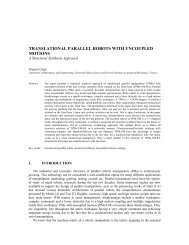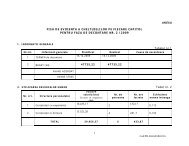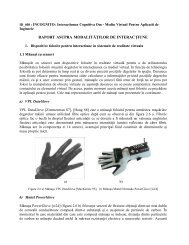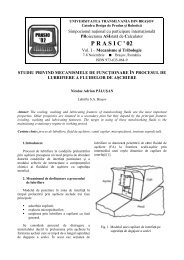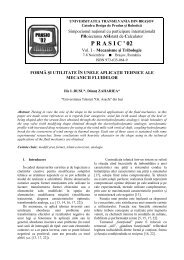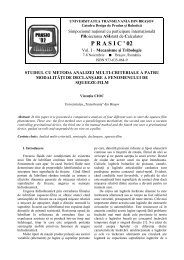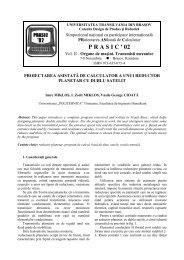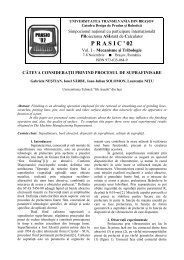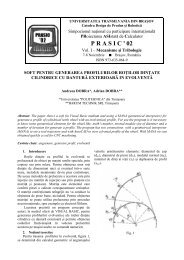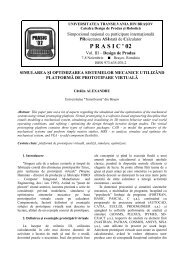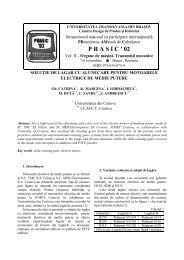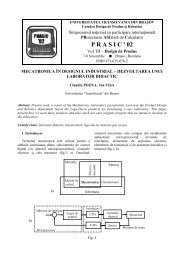real-time mbs formulations: towards virtual engineering
real-time mbs formulations: towards virtual engineering
real-time mbs formulations: towards virtual engineering
Create successful ePaper yourself
Turn your PDF publications into a flip-book with our unique Google optimized e-Paper software.
178 J. Cuadrado, M. Gonzalez, R. Gutierrez, M.A. Naya<br />
stop is attained. In this way, the bending modes of the chassis are excited. The described maneuver is<br />
illustrated in Figure 7.<br />
To obtain the motion of the car, four tri-axial<br />
accelerometers have been attached to the chassis at the four<br />
corners of its base. Accelerations provided by the sensors<br />
in the motion direction have been integrated twice in order<br />
to obtain the position and velocity of the chassis at all<br />
<strong>time</strong>s. On the other hand, four Wheatstone bridges have<br />
been installed at four points of the chassis to measure<br />
bending stresses. They are half-bridges, with an upper and<br />
a lower band each, to measure the normal bending stresses<br />
on the steel tubes surfaces. The sixteen captured signals –<br />
twelve accelerations and four strains– were recorded by a<br />
laptop PC after passing through a data-adquisition board..<br />
The actual maneuver of 15 s has been simulated by<br />
implementation of the proposed formulation, with a fixed <strong>time</strong>-step of 0.01 s, the same sample period<br />
used for data adquisition during the experimental test, where a low-pass filter was applied with a<br />
cutoff frequency of 10 Hz to avoid noise from engine vibration.<br />
4.1 Accuracy<br />
Figure 7. The maneuver<br />
The comparison between measured and calculated bending moments at a certain point of the<br />
chassis is shown in Figure 8. At the view of the results, three <strong>time</strong> intervals can be distinguished.<br />
The first one is the [0,5] interval. During this period of <strong>time</strong>, the car is at rest, but some peaks can<br />
be detected at about 2 s. They are explained because, at that <strong>time</strong>, the gear was set on drive position.<br />
This kind of engine loads is not considered by the model<br />
since engine torque is derived from acceleration<br />
information. Therefore, if the car is at rest, no engine<br />
torque is introduced in the model. This fact justifies the<br />
discrepancies shown between measurements and<br />
calculations during this <strong>time</strong> interval.<br />
The second <strong>time</strong> interval is [5, 10]. During this five<br />
seconds, the car accelerates, goes over the curb, and<br />
brakes until reaching the rest again. Good correlation is<br />
found during the accelerating and braking phases. The<br />
high peaks due to the falling action are not perfectly<br />
reproduced, although their intensities are reasonably<br />
Figure 8. Comparison of bending moments<br />
captured. An explanation for such peak discrepancy can<br />
be the appearance of percussional forces in the actual<br />
prototype, due to the presence of clearances in some joints which have not been modeled.<br />
The third and final <strong>time</strong> interval is [10, 15], when the vehicle is again at rest. Some amount of error<br />
in the measurements can be detected in the figures, since the bending moments should return to zero,<br />
given that the initial and final positions of the car are exactly the same. However, the calculations<br />
come back correctly to zero.<br />
4.2 Efficiency and robustness<br />
The proposed formulation has shown an efficient behavior in the analysis of this case-study. The<br />
method was implemented on Fortran language, and the CPU <strong>time</strong> spent to run this 15-secondsimulation<br />
was 48 s, that is, only a factor of 3 to <strong>real</strong>-<strong>time</strong> performance. The average number of<br />
Newton-Raphson iterations to attain convergence into each <strong>time</strong>-step of 0.01 s was equal to 2, needing<br />
a maximum of 3 iterations at the more difficult points.



